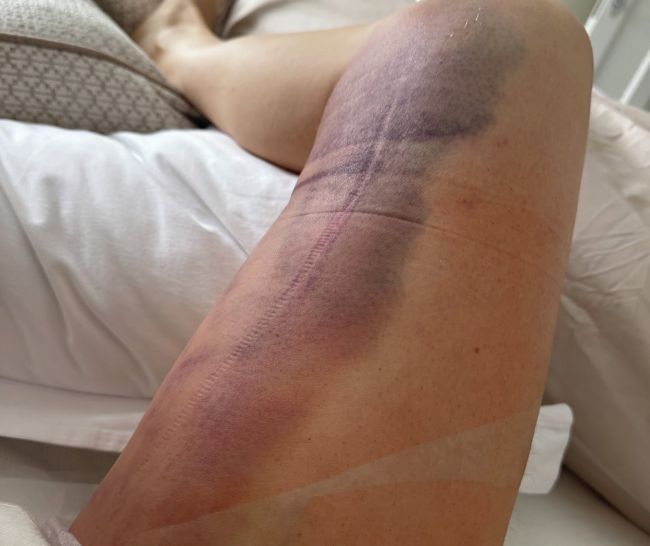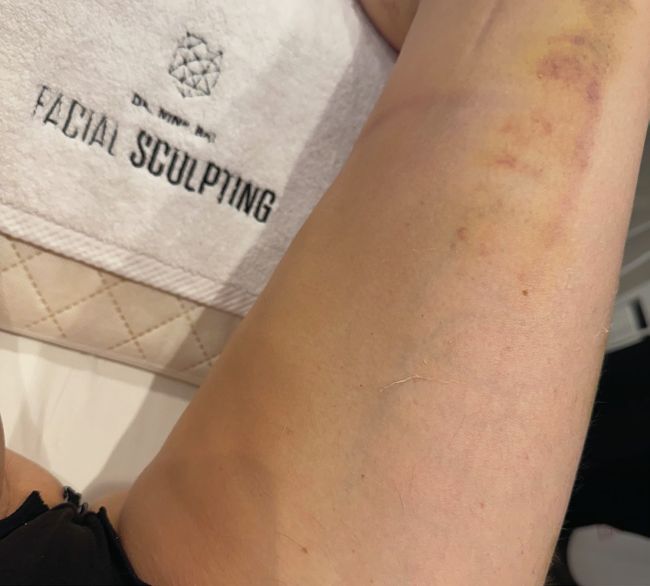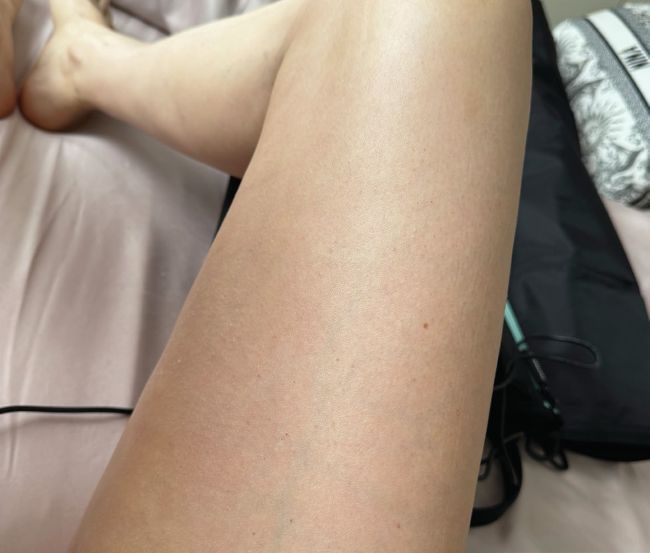Case study: INTEGRATING LED PHOTOTHERAPY INTO POST-OPERATIVE TREATMENT RECOVERY
In this case study, Dr Nina Bal integrates the Dermalux Tri-Wave MD into her post-recovery treatment plan following VASER liposuction.
PATIENT OVERVIEW
Patient: Female
Profession: Cosmetic dental surgeon & aesthetics
practitioner
Practitioner: Dr Nina Bal
Product Intervention: LED
Phototherapy Device: Dermalux Tri-Wave MD
Presenting Complaint: Significant swelling post-VASER liposuction
As a clinician and founder of the Facial Sculpting Clinic, I have been recommending LED phototherapy to my patients for facial rejuvenation and post-injectable recovery for some while, but recently, I had the opportunity to experience it first- hand, not for my face, but for my own body contouring recovery.
I recently underwent a VASER liposuction procedure which was combined with skin tightening. As part of my recovery, I incorporated the Dermalux Tri-Wave MD, a system I have trusted for years for my patients. The results I witnessed first-hand were impressive and the experience provided me with valuable insights into healing, patient compliance, and the underestimated challenges of recovery. It also reinforced my confidence in the role of LED therapy as a core element in post-treatment care.
WHY VASER AND WHY LED PHOTOTHERAPY?
VASER (Vibration Amplification of Sound Energy at Resonance) liposuction is a minimally invasive technique that uses ultrasonic energy to selectively emulsify fat. Compared with traditional liposuction, it typically causes less trauma to surrounding tissues. Even so, the recovery process often involves significant oedema, bruising and tenderness, particularly in vascular or lymphatically dense areas. I was well-informed about the recovery process: compression garments to be worn 24/7, lymphatic drainage massage, foam padding along with the mobility restrictions. Still, I found the early days more physically and logistically demanding than I had anticipated.
In my clinic, I use the Dermalux Tri-Wave MD, a medical grade LED phototherapy device which stimulates cellular repair, modulates inflammation, and promotes lymphatic drainage. The clinically validated light wavelengths used either individually or in combination achieve the following:
· Near-infrared (830 nm): Encourages fibroblast and keratinocyte activity,accelerates wound healing, and reduces pain by modulating pain pathways.
· Red light (633 nm): Reduces inflammation, stimulates collagen production,and supports skin health, particularly useful in the remodelling stage tominimise fibrosis and improve scarring.
· Blue light (415 nm): Not used in my protocol, but important for its antimicrobialproperties and role in reducing biofilm formation during the inflammationstage.
Photobiomodulation’s mechanism is well-documented. Red and near-infraredwavelengths penetrate the skin, activating cytochrome c oxidase in themitochondrial respiratory chain. This boosts ATP production, modulates cytokineactivity, enhances microvascular perfusion, and stimulates collagen synthesis. For post-procedural patients, this means a shorter inflammatory phase, reducedoedema, and a potentially faster, more comfortable recovery. For me, the question was, could it do for my body what I’ve seen it do for patients’ faces?

Before LED phototherapy

During LED phototherapy
MY RECOVERY PROTOCOL
I began LED therapy three days after the VASER Lipo procedure. My protocol was asfollows:
• Week 1: Three sessions
• Week 2: Two sessions
• Duration: 20 minutes each
• Wavelengths: Red and near-infrared, delivering 126 J/cm² and 66 J/ cm²respectively
• Positioning: Legs elevated to aid lymphatic return
• No topical products, as my skin was still highly reactive.
The sessions were unexpectedly soothing. The warmth of the light felt restorative rather than clinical, providing moments of calm in an otherwise rigid recovery schedule. By day five, the swelling and bruising on my legs had noticeably improved. My team confirmed that they, too could see the difference when I returned to work. My pain subsided faster than expected, making garments and massages more tolerable. I didn’t need arnica or cooling therapy, which I had anticipated using. From a clinician’s perspective, these benefits are significant: faster symptom resolution, improved comfort, and a recovery process that feels more manageable, especially for patients like me who are juggling work and young children.
THE IMPACT ON MY PRACTICE AND MY TREATMENT PROTOCOLS
Experiencing these benefits first-hand has transformed the way I discuss recovery protocols with patients. My confidence in recommending LED phototherapy for post-treatment recovery is now based not only on literature but on my own experience. It has also had an effect on my team who are now more proactively suggesting LED phototherapy for post-procedural care.
My own recovery confirms that LED phototherapy is a highly effective, well-tolerated adjunct for post-procedural body contouring. It offers both clinical and business advantages; fewer post-treatment issues, faster recovery and stronger word-of-mouth referrals.
For more information on the Dermalux Tri-Wave MD and its applications in facial and body wound healing visit dermalux.com.

After LED phototherapy
DR NINA BAL
Dr Nina Bal is a cosmetic dental surgeon and advanced facial aesthetics clinician. For over 12 years, Dr Nina has been specialising and practising facial aesthetic enhancements. She is known for her facial sculpting and full-face holistic assessment and treatments. Dr Nina’s services include skin consultations, restorative cosmetic dentistry, facial aesthetic treatments, non-surgical cosmetic procedures and non-surgical facial rejuvenation treatments. She is a member of the General Dental Council, IAFFA and JCCP. Dr Nina has offered her expertise on several television programmes such as Body Fixers, This Morning, BBC News, and has featured in articles for the likes of Forbes and Tatler.